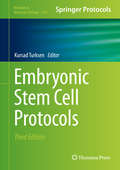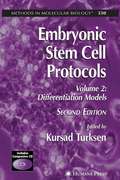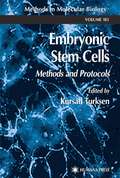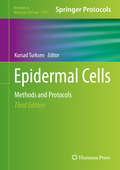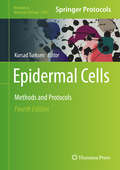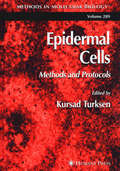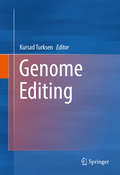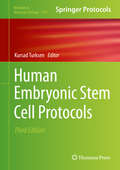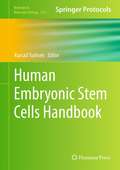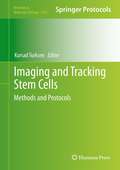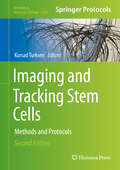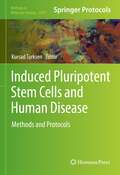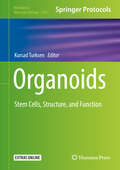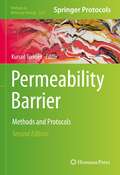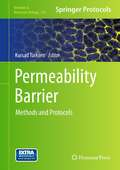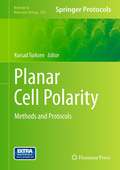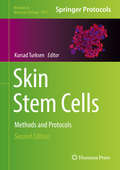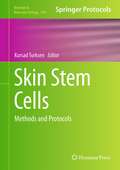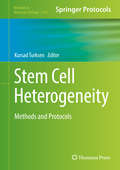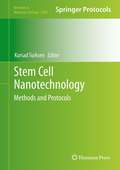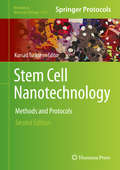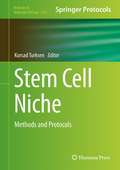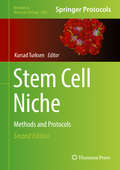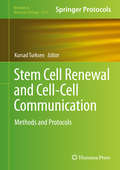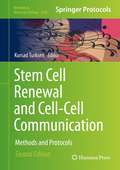- Table View
- List View
Embryonic Stem Cell Protocols, 3rd Edition
by Kursad TurksenThis extensive volume explores areas of intense activity related to the very early commitment of stem cells to particular lineages and the progression of differentiation to mature cell stages. Research on embryonic stem cells continues to move very quickly, thus the kinds of studies continue to expand and diversify, and methodologies are continuously being refined and improved, which this book reflects. Written in the highly successful Methods in Molecular Biology series format, chapters include introductions on their respective topics, lists of the necessary materials and reagents, step-by-step, readily reproducible laboratory protocols, and tips on troubleshooting and avoiding known pitfalls.<P><P> Comprehensive and fully updated, Embryonic Stem Cell Protocols, Third Edition serves as an ideal reference for researchers investigating this rich area of study.
Embryonic Stem Cell Protocols, Volume II: Differentiation Models, 2nd Edition
by Kursad TurksenDrawing on the dramatically increasing research on embryonic stem (ES) cell biology and differentiation, Kursad Turksen has completely updated and expanded his highly acclaimed first edition of Embryonic Stem Cells: Methods and Protocols into two volumes. The second volume, Embryonic Stem Cell Protocols: Differentiation Models, Second Edition, covers state-of-the-art methods for deriving many types of differentiating cells from ES cells. A companion first volume, Embryonic Stem Cell Protocols: Isolation and Characterization, Second Edition, focuses on ES cells recently isolated from different nonhuman species, to provide a diverse collection of readily reproducible cellular and molecular protocols for the isolation, maintenance, and characterization of embryonic stem cells. The protocols follow the successful Methods in Molecular Biology™ series format, each offering step-by-step laboratory instructions, an introduction outlining the principles behind the technique, lists of the necessary equipment and reagents, and tips on troubleshooting and avoiding known pitfalls. <P><P> Authoritative and cutting-edge, the two volumes of Embryonic Stem Cells illuminate for both novices and experts not only our current understanding of the biology of embryonic stem cells and their utility in normal tissue homeostasis and regenerative medicine applications, but also provide detailed accounts of the tools required for successful work in the area.
Embryonic Stem Cells
by Kursad TurksenKursad Turksen and a panel of international experts describe their most productive methods for using embryonic stem (ES) cells as in vitro developmental models for many cell and tissue types. Set out in step-by-step detail, these protocols range widely from ES cell isolation, maintenance, and modulation of gene expression, to cutting-edge techniques that use cDNA arrays in gene expression analysis and phage display libraries, the generation of antibodies against very rare antigens, and the identification of and characterization of protein and protein interactions. Embryonic Stem Cells: Methods and Protocols will prove an invaluable resource not only for those interested generally in cell and developmental biology, but also for those actively using, or planning to use ES cells, to study fate choices and specific lineages.
Epidermal Cells: Methods and Protocols, Third Edition
by Kursad TurksenReflecting over three decades of advances, Epidermal Cells: Methods and Protocols, Third Edition underscores these advances in our understanding of epidermal biology with updated and entirely new protocols that compliment and extend the earlier edition. The inclusion of protocols useful for both in vitro and in vivo studies reflects many useful developments in the field. Written in the highly successful Methods in Molecular Biology series format, chapters include introductions to their respective topics, lists of the necessary materials and reagents, step-by-step, readily reproducible laboratory protocols and tips on troubleshooting and avoiding known pitfalls.<P><P> Dependable and easy to follow, Epidermal Cells: Methods and Protocols, Third Edition serves researchers working to accelerate the work in this vital field of study.
Epidermal Cells: Methods and Protocols (Methods in Molecular Biology #2109)
by Kursad TurksenThis fully updated edition brings together a new set of protocols to arm epidermal cell biologists with tools and approaches to continue the quest to uncover the intricacies and regulatory mechanisms underlying epidermal cell development and function. The collection takes a detailed view at techniques currently being applied to this developing field. Written for the highly successful Methods in Molecular Biology series, chapters include introductions to their respective topics, lists of the necessary materials and reagents, step-by-step, readily reproducible laboratory protocols, and tips on troubleshooting and avoiding known pitfalls. Comprehensive and cutting-edge, Epidermal Cells: Methods and Protocols, Fourth Edition serves as a valuable reference for experts as well as novices in the epidermal cell field.
Epidermal Cells
by Kursad TurksenA collection of cutting-edge methods to analyze and manipulate epidermal cellprecursors and mature epidermal cells. These protocols cover different methods and models for culturing epidermal cells, for enriching very early epidermal progenitors, and for studying epidermal cell commitment and differentiation both in vitro and in vivo. Topics of special interest include the derivation, characterization, and utility of epidermal stem cells, mature epidermal cells and their characterization, and applications in regenerative medicine. These readily reproducible techniques broaden our understanding of the biology of epidermal cells and of their utility in normal tissue homeostasis and regenerative medicine applications.
Genome Editing
by Kursad TurksenThis timely volume explores the use of CRISPR-Cas9 for genome editing, presenting cutting-edge techniques and their applications in treatment of disease. The chapters describe latest methods such as use of targetable nucleases, investigation of the non-coding genome, mouse genome editing, increasing of knock-in efficiency in mouse zygotes, and generation of reporter stem cells; the text contextualizes these methods in treatment of cardiovascular disease, diabetes mellitus, retinitis pigmentosa, and others. The final chapters round out the book with a discussion of controversies and future directions. Genome Editing is an essential, of-the-moment contribution to this rapidly growing field. Drawing from a wealth of international perspectives, it presents novel techniques and applications for the engineering of the human genome. This book is essential reading for all clinicians and researchers in stem cells, regenerative medicine, genomics, biochemical and biomedical engineering- especially those interested in learning more about genome editing and applying it in a targeted, specific way.
Human Embryonic Stem Cell Protocols
by Kursad TurksenDespite political and ethical controversies surrounding the study of human embryonic stem (hES) cells, new freedoms in regard to using them for research has allowed interest to remain high in understanding the regulatory mechanisms of stem cell self-renewal, their differentiation along various lineages, and their potential use in regenerative medicine. In Human Embryonic Stem Cell Protocols, Second Edition, internationally respected researchers expand upon the popular first edition and describe in detail their most useful techniques for the molecular and cellular manipulation of these intriguing cells. This diverse collection of readily reproducible methods has been optimized for the derivation, characterization, and differentiation of hES cells, with special attention given to regenerative medicine applications. As a volume of the Methods in Molecular BiologyTM series, chapters include brief introductions to their respective topics, lists of the necessary materials and reagents, step-by-step laboratory protocols, and notes on troubleshooting and avoiding known pitfalls. Comprehensive and cutting-edge, Human Embryonic Stem Cell Protocols, Second Edition offers both novice and expert researchers powerful tools essential to understanding the maintenance and differentiation of human embryonic stem cells, as well as their applications in regenerative medicine today.
Human Embryonic Stem Cells Handbook
by Kursad TurksenConsiderable advances have taken place since the initial isolation and characterization of human embryonic stem (HES) cells; however, significant challenges remain before their potential for restoration and regeneration processes in patients can be realized. Understanding the diversity amongst HES cell lines and realizing the ability to isolate lines with robust differentiation potential remain difficult. In the Human Embryonic Stem Cells Handbook, experts in the field provide an assortment of protocols that have been used by various laboratories around the world so as to allow both novices and experienced investigators to compare and contrast different approaches to HES cell isolation and characterization with the hope that, from these protocols, researchers might standardize approaches for HES cell biology. Written in the Methods in Molecular BiologyTM series format, chapters include introductions to their respective topics, lists of the necessary materials and reagents, step-by-step, readily reproducible laboratory protocols, and tips for troubleshooting and avoiding known pitfalls. Authoritative and accessible, Human Embryonic Stem Cells Handbook serves as a valuable reference for scientists pursuing this vital field and its enormous potential.
Imaging and Tracking Stem Cells: Methods and Protocols
by Kursad TurksenImaging and Tracking Stem Cells: Methods and Protocols gathers representative protocols related to the vital techniques of stem cell imaging and lineage tracing, including that of live cells, both in vivo and in vitro. The detailed chapters presented within have been validated for reproducibility and are described in an easy to follow, step-by-step fashion so as to be valuable for not only experts but also novices in the stem cell field. As with other volumes in the highly successful Methods in Molecular Biology series, chapters conclude with a Notes section, which provides tips on troubleshooting and avoiding known pitfalls. Authoritative and practical, Imaging and Tracking Stem Cells: Methods and Protocols provides both a flavor of the field as it currently is and a source to stimulate new approaches and methodologies by those interested in tracking stem cells and their progeny.
Imaging and Tracking Stem Cells: Methods and Protocols (Methods in Molecular Biology #2150)
by Kursad TurksenThis fully updated book brings together protocols to arm stem cell biologists with tools and approaches to continue uncovering the intricacies and regulatory mechanisms underlying stem cell biology. Through various models and organ systems, the volume reflects the numerous recent advances in cell lineage and lineage tracking. Written for the highly successful Methods in Molecular Biology series, chapters include introductions to their respective topics, lists of the necessary materials and reagents, step-by-step, readily reproducible laboratory protocols, and tips on troubleshooting and avoiding known pitfalls. Authoritative and up-to-date, Imaging and Tracking Stem Cells: Methods and Protocols, Second Edition is an ideal guide for novices and experts alike who are working to expand our knowledge in the field of stem cells.
Induced Pluripotent Stem Cells and Human Disease: Methods and Protocols (Methods in Molecular Biology #2549)
by Kursad TurksenThis detailed volume presents a series of protocols that are representative of recent developments and improvements in induced pluripotent stem cells (iPS cells) and corresponding human disease models. Reflecting the latest technology for generating induced pluripotent stem cells (iPS cells) and their initial characterization, the book explores techniques invaluable both for studies of disease-specific cell types and for their potential applications in regenerative medicine. Written for the highly successful Methods in Molecular Biology series, chapters include introduction to their respective topics, lists of the necessary materials and reagents, step-by-step and readily reproducible laboratory protocols, as well as tips on troubleshooting and avoiding known pitfalls. Authoritative and practical, Induced Pluripotent Stem Cells and Human Disease: Methods and Protocols serves as a vital guide that is valuable for not only experts but also novices in the stem cell field.
Organoids: Stem Cells, Structure, and Function (Methods in Molecular Biology #1576)
by Kursad TurksenThis detailed volume addresses the challenge of how to instruct stem/early progenitor cells to progress through appropriate steps to generate functional 3-dimensional organs, one of the outstanding issues in regenerative medicine. The field of organoids is geared towards defining and demonstrating the in vitro conditions that achieve this goal. Written for the highly successful Methods in Molecular Biology series, chapters include introductions to their respective topics, lists of the necessary materials and reagents, step-by-step, readily reproducible laboratory protocols, and tips on troubleshooting and avoiding known pitfalls. Comprehensive and cutting-edge, Organoids: Stem Cells, Structure, and Function serves as an aid to researchers working in this vital area of research.
Permeability Barrier: Methods and Protocols (Methods in Molecular Biology #2367)
by Kursad TurksenThis detailed edition reflects the significant new findings in the components of permeability barriers and how they work in different tissues with a collection of cutting-edge techniques. Chapters explore the formation, maintenance, regulation, and dynamics of permeability barriers in an effort to push the boundaries of the field. Written for the highly successful Methods in Molecular Biology series, chapters include introductions to their respective topics, lists of the necessary materials and reagents, step-by-step, readily reproducible laboratory protocols, and tips on troubleshooting and avoiding known pitfalls. Authoritative and up-to-date, Permeability Barrier: Methods and Protocols, Second Edition serves as an invaluable guide for both experts but novices in the stem cell field and other related areas of research.
Permeability Barrier
by Kursad TurksenThe significant biological subject, the permeability barrier, is incredibly diverse and vital for a vast assortment of crucial functions in the body. In Permeability Barrier: Methods and Protocols, a variety of experienced researchers contribute techniques to study this complex system in its many forms. Written in the highly successful Methods in Molecular BiologyTM series format, chapters include brief introductions to their respective topics, detailed lists of the necessary materials and reagents, step-by-step, readily reproducible laboratory protocols, and key tips on troubleshooting and avoiding known pitfalls. Authoritative and practical, Permeability Barrier: Methods and Protocols serves as an ideal guide for all scientists seeking to further our understanding of this vital area of research.
Planar Cell Polarity
by Kursad TurksenPlanar cell polarity (PCP), or the alignment of a collection of cells within a cell sheet, has proven, over time, to be vital in not only normal development but also in disease states. In Planar Cell Polarity: Methods and Protocols, expert researchers in the field present a number of detailed and well-designed protocols used successfully in their labs around the world. As a volume in the highly successful Methods in Molecular BiologyTM series, the chapters contain introductions to their respective topics, lists of the necessary materials and reagents, step-by-step, readily reproducible laboratory protocols, and tips on troubleshooting and avoiding known pitfalls. Timely and authoritative, Planar Cell Polarity: Methods and Protocols serves as a valuable reference for both novices and experts in this dynamic and versatile area of study.
Skin Stem Cells: Methods and Protocols (Methods in Molecular Biology #1879)
by Kursad TurksenThis detailed book collects new and updated techniques that will help to improve our understanding of the mechanisms underlying stem cell-derived repair through stem cells of the epidermal and dermal lineages, which have led to the isolation of numerous stem cell-like sub-populations from the epidermis and dermis. Written for the highly successful Methods in Molecular Biology series, chapters include introductions to their respective topics, lists of the necessary materials and reagents, step-by-step, readily reproducible laboratory protocols, and tips on troubleshooting and avoiding known pitfalls. Comprehensive and practical, Skin Stem Cells: Methods and Protocols, Second Edition serves as a valuable assemblage of protocols for researchers both already working in the field and those who now wish to newly embark on studies of skin stem cells.
Skin Stem Cells
by Kursad TurksenDuring the last decade, an increased interest in somatic stem cells has led to a flurry of research on one of the most accessible tissues of the body: skin. Much effort has focused on such topics as understanding the heterogeneity of stem cell pools within the epidermis and dermis, and their comparative utility in regenerative medicine applications. In Skin Stem Cells: Methods and Protocols, expert researchers in the field detail many of the methods which are now commonly used to study skin stem cells. These include methods and techniques for the isolation, maintenance and characterization of stem cell populations from skin. Written in the highly successful Methods in Molecular BiologyTM series format, chapters include introductions to their respective topics, lists of the necessary materials and reagents, step-by-step, readily reproducible laboratory protocols, and key tips on troubleshooting and avoiding known pitfalls. Authoritative and practical, Skin Stem Cells: Methods and Protocols seeks to aid scientists in the further understanding of these diverse cell types and the translation of their biological potential to the in vivo setting.
Stem Cell Heterogeneity
by Kursad TurksenGiven the variety of studies and data that have suggested the existence of heterogeneous populations or subpopulations of stem cells, this detailed volume examines different aspects of stem cell heterogeneity. This goes against the long-held tenet that stem cells, defined by their capacity for self-renewal and lineage development, comprised a homogenous population, thus providing the reader with a new avenue of exploration into the complex world of stem cell study. Written for the highly successful Methods in Molecular Biology series, chapters include introductions to their respective topics, lists of the necessary materials and reagents, step-by-step, readily reproducible laboratory protocols, and tips on troubleshooting and avoiding known pitfalls. Authoritative and practical, Stem Cell Heterogeneity: Methods and Protocols serves as an ideal guide for investigators exploring this important area of research.
Stem Cell Nanotechnology: Methods and Protocols
by Kursad TurksenStem Cell Nanotechnology: Methods and Protocols gathers several representative protocols related to the emerging interest in nanotechnology as it relates to stem cell biology. The detailed chapters presented within have been validated for reproducibility and are described in an easy to follow, step-by-step fashion so as to be valuable for not only experts but also novices in the stem cell field. As with other volumes in the highly successful Methods in Molecular Biology series, chapters conclude with a Notes section, which provides tips on troubleshooting and avoiding known pitfalls. Authoritative and practical, Stem Cell Nanotechnology: Methods and Protocols provides both a flavor of the field as it currently is and a source to stimulate new approaches and methodologies by those interested in nanotechnological applications.
Stem Cell Nanotechnology: Methods And Protocols (Methods In Molecular Biology Ser. #1058)
by Kursad TurksenThis fully updated edition brings together a new set of protocols to arm stem cell biologists with tools and approaches to continue the quest to uncover the intricacies and regulatory circuits underlying stem cell biology. The collection explores the tremendous progress in our understanding of the potential of stem cells and the regulatory mechanisms controlling their fate, particularly through the parallel advances in nanotechnologies and their applications in biology. Written for the highly successful Methods in Molecular Biology series, chapters include introductions to their respective topics, lists of the necessary materials and reagents, step-by-step, readily reproducible laboratory protocols, and tips on troubleshooting and avoiding known pitfalls. Authoritative and practical, Stem Cell Nanotechnology: Methods and Protocols, Second Edition serves a valuable tool for experts and novices alike in the vital field of stem cell research.
Stem Cell Niche: Methods and Protocols
by Kursad TurksenInterest in a specialized microenvironment or "niche" regulating hemopoietic stem cell function has been steadily growing since the idea was first proposed by Ray Schofield over three decades ago. This growing interest, as well as more recently the interest in cellular-molecular-biochemical characterization of not only the hemopoietic stem cell niche but the niches for other stem cells, incited the compilation of Stem Cell Niche: Methods and Protocols. In this volume, scientists have provided protocols that will provide both a flavor of the field and hopefully stimulate new approaches and methodologies by those interested in the stem cell niche. Written in the successful Methods in Molecular Biology series format, chapters include introductions to their respective topics, lists of the necessary materials and reagents, step-by-step, readily reproducible protocols, and notes on troubleshooting and avoiding known pitfalls. Authoritative and easily accessible, Stem Cell Niche: Methods and Protocols seeks to serve both experts and novices in the stem cell field with well-established protocols on this exciting subject.
Stem Cell Niche: Methods and Protocols (Methods in Molecular Biology #2002)
by Kursad TurksenThis updated collection addresses the intense efforts that have been underway to characterize the cellular-molecular-biochemical elements of not only the hematopoietic stem cell niche but the niches for other stem cells. These specialized microenvironments that regulate stem cell function have continued to inspire tremendous interest as a subject of study in the years since the publication of the first edition. Written for the highly successful Methods in Molecular Biology series, chapters include introductions to their respective topics, lists of the necessary materials and reagents, step-by-step, readily reproducible laboratory protocols, and tips on troubleshooting and avoiding known pitfalls. Authoritative and practical, Stem Cell Niche: Methods and Protocols, Second Edition serves as an ideal guide for both experts and novices in the stem cell field.
Stem Cell Renewal and Cell-Cell Communication
by Kursad TurksenThis volume examines cell-cell interactions and stem cell renewal, two topics that are now inexorably linked as science strives to understand the stem cell niche and its function. Gathering a number of representative protocols, this detailed collection promises to provide readers with approaches for studying these complimentary aspects of stem cells. Written for the highly successful Methods in Molecular Biology series, chapters include brief introductions to their respective topics, lists of the necessary materials and reagents, step-by-step, readily reproducible laboratory protocols and tips on troubleshooting and avoiding known pitfalls. Practical and reliable, Stem Cell Renewal and Cell-Cell Communication: Methods and Protocols will aid researchers in using these methods to advance their own studies.
Stem Cell Renewal and Cell-Cell Communication: Methods and Protocols (Methods in Molecular Biology #2346)
by Kursad TurksenThis detailed book brings together a new set of protocols to arm cell biologists with techniques that are currently being used in a number of well-established laboratories around the world. The contents represent the great strides made in the field of cell-cell communications with respect to the identification and characterization of key components of the communication apparatus, assembly and maintenance of the communications structures, and concomitantly their roles in not only tissue formation and maintenance but also regeneration and repair. Written for the highly successful Methods in Molecular Biology series, chapters include introductions to their respective chapters, lists of the necessary materials and reagents, step-by-step, readily reproducible laboratory protocols, and tips on troubleshooting and avoiding known pitfalls. Authoritative and practical, Stem Cell Renewal and Cell-Cell Communication: Methods and Protocols, Second Edition serves as an ideal guide for experts and newcomers alike seeking to increase our understanding of the crucial biological and physiological roles of cell-cell communications in tissue function and organismal integrity.
